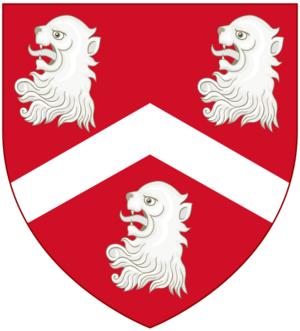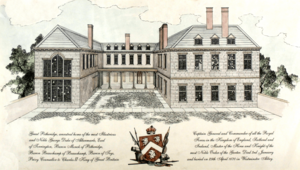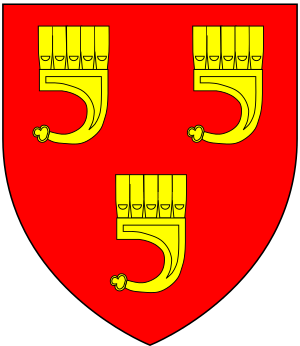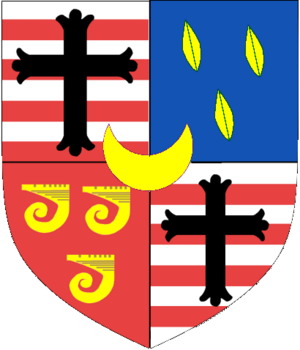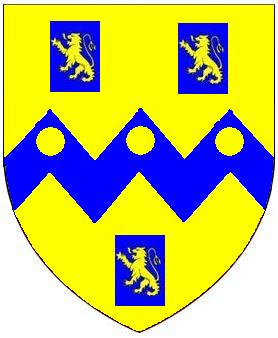Potheridge facts for kids
Potheridge, also known as Great Potheridge, is an old estate in Merton, England. It's about 3 miles south-east of Great Torrington. This place was once home to a huge mansion. It was rebuilt around 1660 by George Monck, 1st Duke of Albemarle (1608–1670). His family had lived there since at least 1287.
Most of the grand mansion was taken down in 1734. This happened after the death of the wife of George Monck's son, Christopher Monck, 2nd Duke of Albemarle (died 1688).
The part that still stands today is called Great Potheridge farmhouse. It's a very old and important building. Inside, you can still see parts of the old mansion. These include a grand staircase and two large 17th-century door frames. There's also a huge wooden carving above a fireplace. This carving shows five small, winged figures called putti. Two of them are flying and holding a crown. This carving reminds us of Monck's important role in bringing the king back to power in 1660.
The old chapel, built in a classical style, was mostly gone by 1822. Only its west wall remained. In 1879, the stables were still standing. They gave visitors an idea of how grand the old building used to be.
In 2014, Great Potheridge and its 6 acres of land became an outdoor activity center for young people. It is run by Encompass Training. It's now called "Great Potheridge" to tell it apart from "Little Potheridge," another nearby house that was once part of the estate.
Contents
Who Owned Potheridge?
Early Owners: Domesday Book
In 1086, a famous book called the Domesday Book listed Potheridge as "Porrige." It was one of many lands owned by Baldwin de Moels. He was the Sheriff of Devon. His tenant, or person who rented the land, was named Aubrey. Before the Norman Conquest, a person named Ulf owned the land.
The Monk Family Takes Over
The Monk family (also spelled Monck or Monke) lived at Potheridge from at least 1287. The family name "Monk" comes from an old French word meaning "the monk."
Many generations of the Monk family lived at Potheridge. Here are some of the important ones:
- Thomas Monk married Frances Plantagenet. She was the daughter of a famous knight, Arthur Plantagenet, 1st Viscount Lisle.
- Sir Thomas Monke (1570–1627) was a Member of Parliament. He married Elizabeth Smith. Her father, Sir George Smith, was a very rich merchant and mayor of Exeter.
- Sir Thomas Monke's fourth son was George Monck, 1st Duke of Albemarle (1608–1670). He became a famous general. He played a key role in bringing King Charles II back to the throne in 1660. This event is known as the Restoration of the Monarchy.
George Monck rebuilt the mansion at Potheridge to be very grand. It was similar to how his cousin, John Grenville, 1st Earl of Bath, rebuilt his own large house nearby. Sadly, both houses were mostly torn down just a few decades later.
- Christopher Monck, 2nd Duke of Albemarle (1653–1688) was George Monck's son. He had no children. He gave a large part of his estate to his cousin, John Grenville, 1st Earl of Bath. After Christopher's wife died in 1734, much of Potheridge House was demolished.
The Granville Family
The Grenville family (later called Granville) was connected to the Monk family through marriages.
- John Grenville, 1st Earl of Bath (1628–1701) received a large part of the Monck estates from his cousin, Christopher Monck.
- John Granville, 1st Baron Granville of Potheridge (1665–1707) was the second son of the 1st Earl of Bath. He was given the title "Baron Granville of Potheridge" in 1703. He had no children.
- William Granville, 3rd Earl of Bath (1692–1711) was John Granville's nephew. When he died at age 19, the male line of the Granville family ended. Potheridge then went to the family of his aunt, Jane Granville.
The Leveson-Gower Family
The Leveson-Gower family inherited Potheridge. However, they quickly sold it to the Rolle family. The Leveson-Gowers remembered their Granville connection. They used the name "Granville" in later family names and titles. For example, one of their family members became Granville Leveson-Gower, 1st Earl Granville.
The Rolle Family
The Rolle family bought Potheridge from the Leveson-Gower family. The Rolles were very rich landowners in Devon. In 1850, Potheridge was managed by the people in charge of John Rolle, 1st Baron Rolle's estate. It was for the benefit of his adopted heir, Mark Rolle (1835–1907). Mark Rolle owned more than 55,000 acres of land, making him the biggest private landowner in Devon.
Later, in 1952, Great Potheridge was used as part of the buildings for Bicton College of Agriculture. This college was about 40 miles away. In 1968, a farmer named Mr. C.W. Lewis lived at Potheridge. He raised Devon cattle and farmed 500 acres of land.
Images for kids


